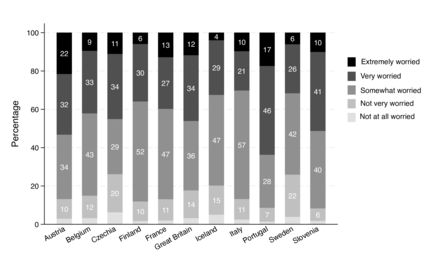Study design and participants
This study used secondary data from the 10th European Social Survey (ESS) (collected during 18 September 2020–3 September 2022),11 12 and subsequent follow-up CROss-National Online Survey 2 (CRONOS-2) wave 4 (collected during 3 May 2022–22 December 2022),13 allowing for a longitudinal study design. All European countries are welcome to participate in the ESS and the data are openly accessible (on registration) at https://www.europeansocialsurvey.org/. ESS10 is a cross-national survey conducted across 31 countries.14 During this survey round, data were collected by a face-to-face interview (via computer-assisted personal interview, web-based video interview or paper/web self-completion methods). The target population was people aged 15 years and over resident within private households, regardless of their nationality, citizenship, language or legal status.14 Individuals were selected by strict random probability methods, including simple, stratified and multistage methods. Further detailed information regarding the methodology of ESS10 is found elsewhere.14
CRONOS-2 is a cross-national, probability-based input-harmonised web panel. It was conducted across 12 of the countries which took part in ESS10: Austria, Belgium, Czechia, Finland, France, Hungary, Iceland, Italy, Portugal, Slovenia, Sweden and Great Britain—as a follow-up panel survey across six waves.15 Since the data used in this study were taken from wave 4 (when mental health was assessed), this limited the sample to 11 countries (excluding Hungary which did not complete wave 4). The CRONOS-2 web panel included additional inclusion criteria; participants were required to be 18 years or older and needed internet access.15 CRONOS-2 participants were offered unconditional incentives for a value of £5/€5 per wave. Since participants were recruited after taking part in ESS10, this allowed for panel member recruitment from random probability samples and longitudinal follow-up. Response rates ranged from 34.6% in Italy to 86.5% in Iceland.15 The two datasets (ESS10 and CRONOS-2 wave 4) were merged together using the participant identification number, country and survey mode. A total of 18 637 ESS10 respondents were eligible for CRONOS-2 recruitment.15 16
Exposure, outcomes and covariates
Climate change worry (exposure variable) was measured via the question which asked, “How worried are you about climate change?”, during the ESS10 survey (baseline). Respondents were asked to choose an option from a 5-point Likert scale which ranged from 1 (not at all worried) to 5 (extremely worried). The responses ‘not at all worried’, ‘not very worried’ and ‘somewhat worried’ were grouped as ‘not worried about climate change’, whereas the responses ‘very worried’ and ‘extremely worried’ were grouped as ‘worried about climate change’ to form a binary variable.
To measure depression (outcome variable), the Centre for Epidemiologic Studies-Depression Scale (CES-D 8)17 block of questions was used from CRONOS-2 wave 4. These questions form an 8-item adapted version of the original CES-D questionnaire18—a 20-item measure asking respondents to rate how often over the past week they have experienced symptoms of depression. The four possible response options were ‘rarely or none of the time’, ‘some of the time’, ‘often’ and ‘most or all of the time’, which were scored from 0 to 3, respectively. To assess anxiety (outcome variable), the Generalised Anxiety Disorder Assessment-7 block of questions19 was used from the CRONOS-2 wave 4 web panel. These questions explored how often respondents experienced symptoms of anxiety over the past 2 weeks. The four possible response options were ‘rarely or none of the time’, ‘some of the time’, ‘often’ and ‘most or all of the time’ and the responses were scored from 0 to 3, respectively. For depression and anxiety, the overall scores for each block of questions were calculated, and a cut-off of 10 was applied for potential clinical (moderate/severe) depression or anxiety, according to relevant guidelines.19 20
To assess sleep disturbance (outcome variable), one of the questions from the CES-D 8 block was used, which asked respondents how often in the past week they had experienced restless sleep. Sleep disturbance was converted into a binary variable by grouping the responses ‘rarely or none of the time’ and ‘some of the time’ as not experiencing sleep disturbance, and grouping ‘often’ and ‘most or all of the time’ as positive for experiencing sleep disturbance.
Baseline characteristic data of the respondents were obtained from the ESS10 survey. This included the age of respondents, gender, education level, income level, whether they lived in a rural or urban setting, their country of residence and whether they were a migrant. These were included as model covariates as they were thought to potentially confound the relationship between climate change worry and the outcomes. Education level was determined in ESS10 using an adapted version of the International Standard Classification of Education (ISCED) 2011.21 The European Survey-ISCED (ES-ISCED) split highest educational attainment into eight tiers, ranging from less than primary education to a doctoral degree or equivalent.14 This was categorised into low, intermediate and high levels of education by grouping ES-ISCED 1–2, ES-ISCED 3–5 and ES-ISCED 6–8, respectively.
A decile approach was used to measure income, based on national deciles of the actual household income range in each country.14 Respondents estimated their household’s total income from all sources, after tax and compulsory deductions, and selected 1 of 10 income deciles which applied to them. Income levels were then grouped into low, middle and high income by grouping deciles 1–3, deciles 4–7 and deciles 8–10, respectively.
To assess living in an urban or rural setting, respondents chose the most appropriate description of their domicile, which ranged from ‘a big city’, ‘suburbs or outskirts of a big city’, ‘town or small city’, ‘country village’ to ‘farm or home in countryside’.14 The former three categories were grouped as urban and the latter two were grouped as rural. Migration status was derived from a survey item which asked participants whether they were born in their current country of residence (yes/no).
Statistical analysis
Three analyses were conducted to investigate the research questions. First, to determine which countries had the highest levels of climate change worry, climate change worry was summarised descriptively using percentages and graphs, stratifying respondents by country. Next, to investigate the relationship between climate change worry and risk of depression, anxiety and sleep disturbance, two logistic regression analyses were applied. The associations were reported as ORs with 95% CIs.
The first set of models investigated the relationship between climate change worry and depression, anxiety and sleep disturbance in a pooled cross-country analysis. Great Britain was chosen as the reference country for all analyses. The first model of this analysis adjusted for country fixed effects, the second model adjusted for country fixed effects, age and gender, and the third model adjusted for country, age, gender, migrant status, urban/rural status, education and income level. The second set of models investigated the relationship between climate change worry and depression, anxiety and sleep disturbance while stratifying by country to investigate potential differences between countries, adjusting for confounders as in the first set of models.
Respondents who had missing values for any of the variables included in the models were excluded from the analyses to conduct a complete case analysis. All tables and analyses were weighted as recommended.15 All analyses were performed using Stata/MP V.18.0.


